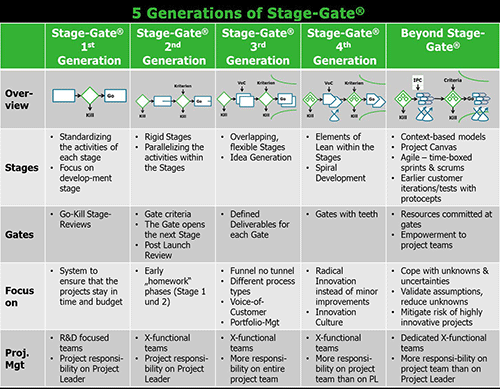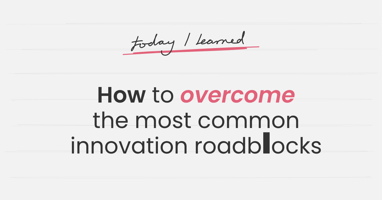 [/fusion_lightbox] [fusion_separator style_type="none" bottom_margin="40"/] Stage-Gate works, yet complaints remain:
Stage-Gate processes are too controlling. They decayed at some companies to a check box workflow with no more room for flexibility or creativity. All new product projects try to be managed as projects under full knowledge with no uncertainties or risks. Experimentation and learning loops are difficult to plan, so project teams and gatekeepers try to avoid or even disavow them.
Many traditional markets are mature now. In these markets, the products are more and more often commodities. There are many competitors and increasingly price-sensitive customers. Never the less, the expectations of the shareholders remain high. With only product improvements, the growth and margin targets cannot be reached any longer. Yet at many companies the established Stage-Gate processes are mainly used to administrate projects with easily predictable risks. Projects with higher uncertainties tend to get killed at early gates. We have even heard the words “Stage-Gate is killing our innovations” at some companies.
The world is faster and less predictable today. Customer problems, needs and wants change more frequently and sometimes it is difficult to research them at all. Users can only articulate what they want when they have a functional “product” in their hands. This makes an early product description much more difficult. So what is coming next, after the 4th generation of Stage-Gate? While the system stays the same and benefits high efficiency for product improvements, there are major changes for the more radical innovations.
Adaptive and Flexible, Agile, and Accelerated The next-generation idea-to-launch system is adaptive and context based. First, a project team needs to identify what the uncertainties and risks of the project are. The more uncertainties the project is facing, the more flexible the management of it should be. This incorporates several build/test/revise iterations, each time interfacing with the customer or user. A risk-based contingency model dictates the activities and deliverables of the stages. The product may be less than 50% defined when it enters development, but it evolves, adapting to new information, as it moves through development and testing. Not freezing a product specification before development calls for agile development. While in classical project management the scope (e.g. product definition) of the project is fixed, and the costs (e.g. manpower) and the timing are flexible, it is in agile development the other way around. Within a sprint the resources and the time of a sprint are strictly determined. But what will be reached with the sprint effort is much more open. Agile development emphasize on moving quickly and nimbly from milestone to milestone and rely on a much leaner system with all waste removed—no bureaucracy, no unnecessary activities anywhere in the system. To accelerate the process the innovation projects need to be properly resourced and fully staffed by a dedicated cross-functional team. These teams really feel responsible and are more accountable for the project result. The role of the gatekeepers becomes less important. To lead more radical innovations successfully through the organization and on the market the teams need an entrepreneurial attitude. Activities within stages overlap, and even stages overlap: The notion of a “stage” is less relevant in this new system. There is more emphasis on the fuzzy front-end, making it sharper and less fuzzy, so that the project is clearly scoped and key unknowns, risks, and uncertainties identified as early as possible. The 5th generation, “Beyond Stage-Gate®” takes into account special requirements to develop successfully and quickly the more ambitious innovations. The system describes: [/fusion_builder_column][fusion_builder_column type="1_1" background_position="left top" background_color="" border_size="" border_color="" border_style="solid" spacing="yes" background_image="" background_repeat="no-repeat" padding="" margin_top="0px" margin_bottom="0px" class="" id="" animation_type="" animation_speed="0.3" animation_direction="left" hide_on_mobile="no" center_content="no" min_height="none"][fusion_checklist icon="chevron-sign-right" iconcolor="#569ba7" circle="no"]
[/fusion_lightbox] [fusion_separator style_type="none" bottom_margin="40"/] Stage-Gate works, yet complaints remain:
Stage-Gate processes are too controlling. They decayed at some companies to a check box workflow with no more room for flexibility or creativity. All new product projects try to be managed as projects under full knowledge with no uncertainties or risks. Experimentation and learning loops are difficult to plan, so project teams and gatekeepers try to avoid or even disavow them.
Many traditional markets are mature now. In these markets, the products are more and more often commodities. There are many competitors and increasingly price-sensitive customers. Never the less, the expectations of the shareholders remain high. With only product improvements, the growth and margin targets cannot be reached any longer. Yet at many companies the established Stage-Gate processes are mainly used to administrate projects with easily predictable risks. Projects with higher uncertainties tend to get killed at early gates. We have even heard the words “Stage-Gate is killing our innovations” at some companies.
The world is faster and less predictable today. Customer problems, needs and wants change more frequently and sometimes it is difficult to research them at all. Users can only articulate what they want when they have a functional “product” in their hands. This makes an early product description much more difficult. So what is coming next, after the 4th generation of Stage-Gate? While the system stays the same and benefits high efficiency for product improvements, there are major changes for the more radical innovations.
Adaptive and Flexible, Agile, and Accelerated The next-generation idea-to-launch system is adaptive and context based. First, a project team needs to identify what the uncertainties and risks of the project are. The more uncertainties the project is facing, the more flexible the management of it should be. This incorporates several build/test/revise iterations, each time interfacing with the customer or user. A risk-based contingency model dictates the activities and deliverables of the stages. The product may be less than 50% defined when it enters development, but it evolves, adapting to new information, as it moves through development and testing. Not freezing a product specification before development calls for agile development. While in classical project management the scope (e.g. product definition) of the project is fixed, and the costs (e.g. manpower) and the timing are flexible, it is in agile development the other way around. Within a sprint the resources and the time of a sprint are strictly determined. But what will be reached with the sprint effort is much more open. Agile development emphasize on moving quickly and nimbly from milestone to milestone and rely on a much leaner system with all waste removed—no bureaucracy, no unnecessary activities anywhere in the system. To accelerate the process the innovation projects need to be properly resourced and fully staffed by a dedicated cross-functional team. These teams really feel responsible and are more accountable for the project result. The role of the gatekeepers becomes less important. To lead more radical innovations successfully through the organization and on the market the teams need an entrepreneurial attitude. Activities within stages overlap, and even stages overlap: The notion of a “stage” is less relevant in this new system. There is more emphasis on the fuzzy front-end, making it sharper and less fuzzy, so that the project is clearly scoped and key unknowns, risks, and uncertainties identified as early as possible. The 5th generation, “Beyond Stage-Gate®” takes into account special requirements to develop successfully and quickly the more ambitious innovations. The system describes: [/fusion_builder_column][fusion_builder_column type="1_1" background_position="left top" background_color="" border_size="" border_color="" border_style="solid" spacing="yes" background_image="" background_repeat="no-repeat" padding="" margin_top="0px" margin_bottom="0px" class="" id="" animation_type="" animation_speed="0.3" animation_direction="left" hide_on_mobile="no" center_content="no" min_height="none"][fusion_checklist icon="chevron-sign-right" iconcolor="#569ba7" circle="no"]
- The fuzzy front-end (how to generate great new, more radical ideas and make them into winning concepts),
- The Idea-to-Launch System (how to live an adaptive, agile and accelerated system), and
- The right culture and attitude of the project teams and the gatekeepers.





